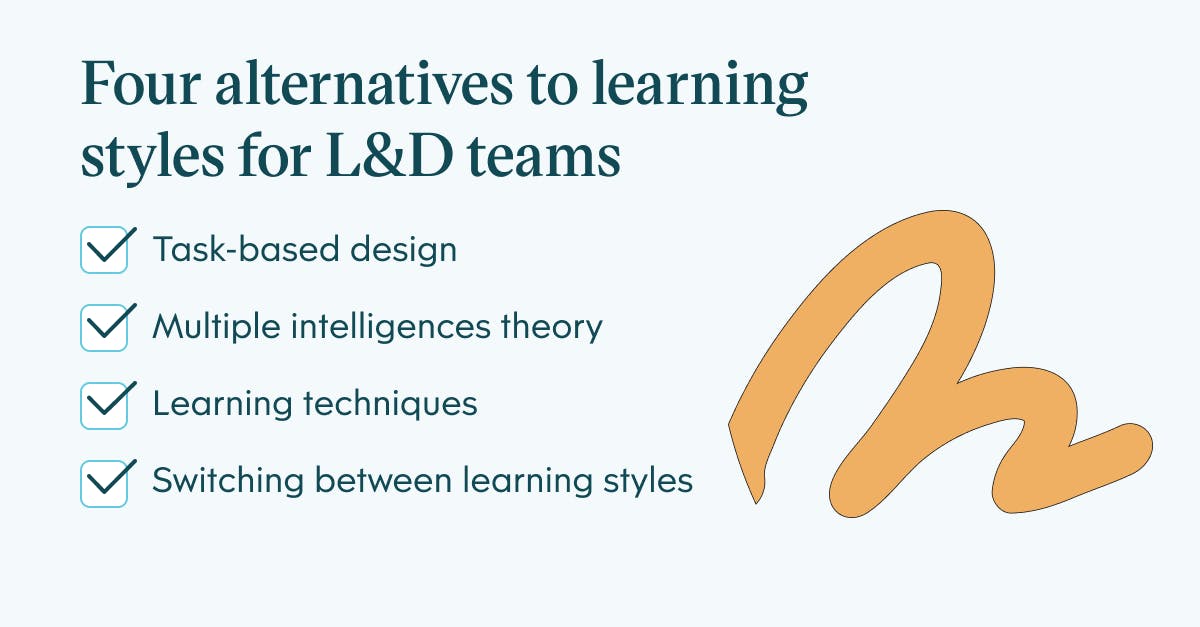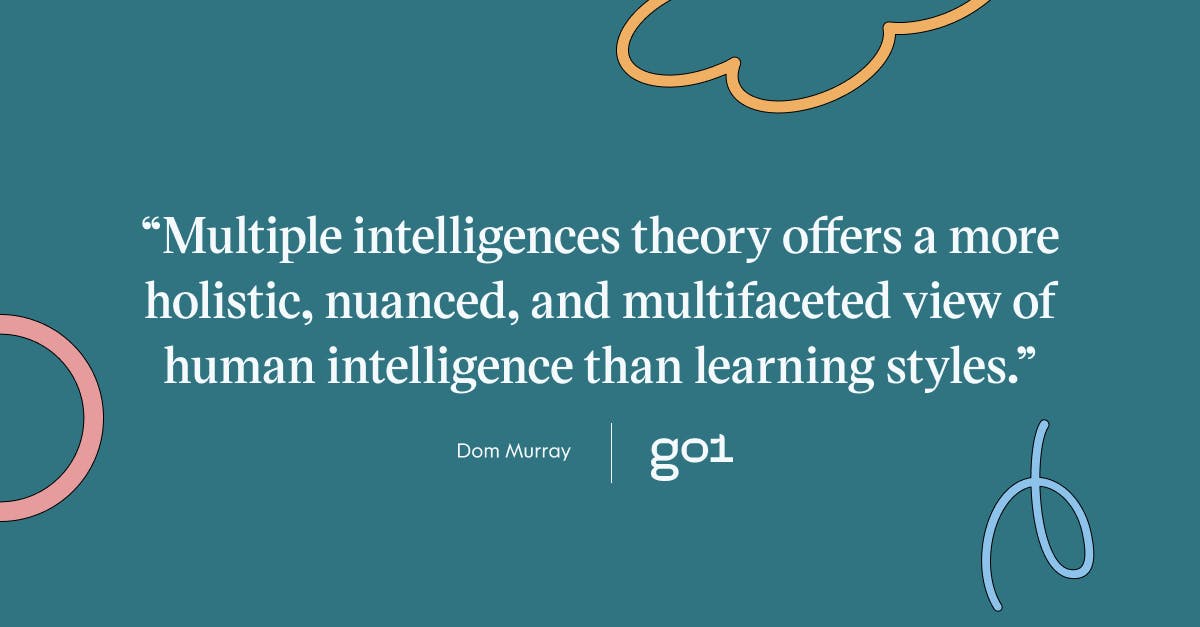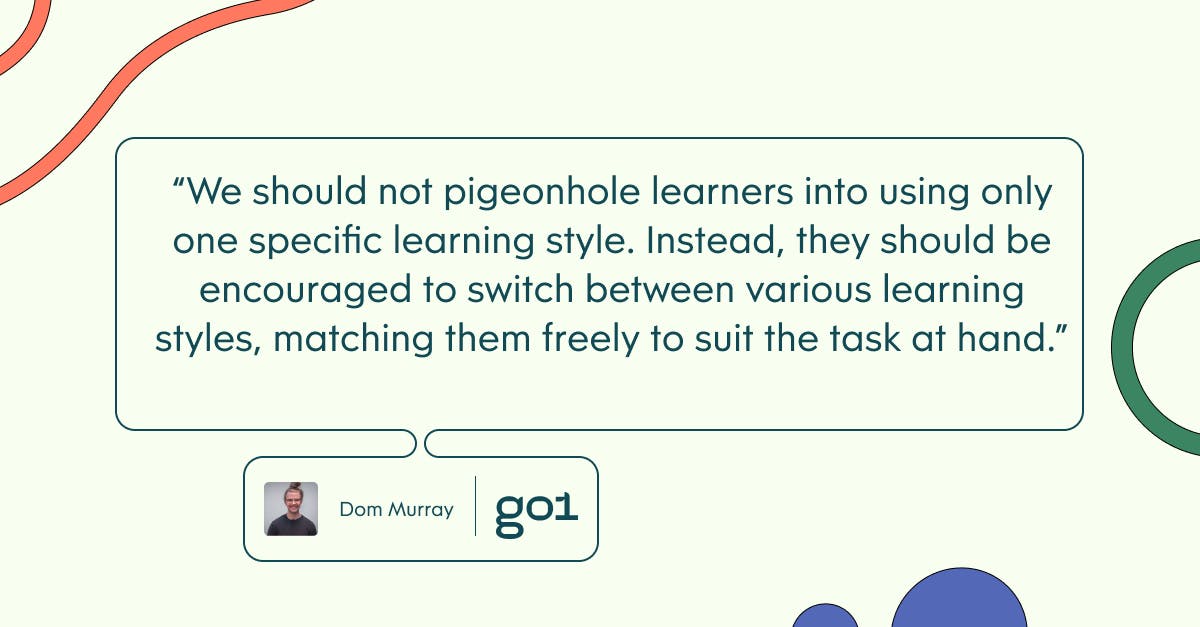
What should L&D teams be using instead of learning styles?

Are you a visual learner or an aural learner? Perhaps, you learn best by doing. Well, according to several studies, the answer may be ‘none of the above’. This revelation may surprise those who grew up believing they had a particular learning style. However, the science is unequivocal.
As we discussed in our previous article, an overwhelming body of evidence from leading neuroscientists and education professionals proves that learning styles are a myth. Still, not everyone is convinced. After publishing our article, we put the question out to you in a poll on LinkedIn, with a resounding 76% of respondents saying that learning styles are valid, compared to just 24% who believe they are a myth.

So, we’ve decided to delve deeper into the topic by posing the question: if not learning styles, then what? What should L&D teams be using instead of learning styles? With this in mind, we’ll analyse four alternatives to learning styles, including task-based design, multiple intelligences theory, learning techniques, and switching between learning styles.
Before we get started, check out the first article in this series on whether learning styles are a myth or valid for a quick refresher.
Four alternatives to learning styles
Firstly, it’s worth pointing out that there are as many different learning theories as stars in the sky. Accordingly, this is not an exhaustive list, but rather, four alternatives to learning styles that we believe stand out.
For more insights on other alternatives to learning styles, see our articles on sticky learning, learning in the flow, productivity hacks, and how technology has changed the way we learn.

Task-based design
Task-based design is one of the best alternatives to learning styles for L&D teams. To explain why task-based design is more effective than learning styles, take the example of a driver’s education class where students learn how to parallel park.
Typically, this class would involve a kinesthetic element (practising parallel parking) along with visual and aural instructions, such as explanations, diagrams, videos, lectures, and more. Tasks such as these, which involve multiple steps and encompass several learning styles, are where prescriptive learning styles are insufficient.
As Training Industry explains: “no competent teacher would say to a ‘visual learner’ that all they have to do in order to succeed at parallel parking is to watch an expert performance of the task and they are good to go.” Likewise, you wouldn’t assume that verbal instructions are sufficient for ‘aural learners’ to parallel park competently.
Enter, task-based design. Put simply, task-based design means evaluating the task or skill you want learners to acquire and training them in a manner that mimics performing that task. Ask yourself, “what do I want learners to do at the end of this training that they aren’t doing now?”
Effectively implemented task-based design combines three vital areas of learning: knowledge, skills, and attitudes (KSAs). To successfully implement task-based design in your training, start by asking the following questions:
- What must learners know or understand to complete this task? (Knowledge)
- What must learners do to complete this task? (Skill)
- What must learners feel or believe to complete this task? (Attitude)
Training Industry offers a helpful step-by-step guide to implementing task-based design, saying, “we should be guided not by the myth of learning styles, but by the reality of how the task will be performed in the live environment. Our goal as designers is to create meaningful practice that closely simulates the live performance of the task as much as possible. If the task is complex, we break the learning into progressive steps that allow learners to acquire the skills gradually until they can complete the whole task.”
Multiple intelligences theory
First outlined by Harvard psychologist Dr Howard Gardner in 1983, multiple intelligences theory is another fantastic alternative to learning styles. Gardner’s theory identifies eight distinct types of human intelligence: visual-spatial, linguistic-verbal, interpersonal, intrapersonal, musical, logical-mathematical, naturalistic, and bodily-kinesthetic.
As Very Well Mind explains, Gardner's theory better captures the full spectrum of talents, knowledge, and abilities that people possess. They elaborate, adding, “Gardner theorises that people do not have just an intellectual capacity, but have many kinds of intelligence…while a person might be particularly strong in a specific area…he or she most likely possesses a range of abilities.”
Accordingly, multiple intelligences theory offers a more holistic, nuanced, and multifaceted view of human intelligence than learning styles. Whereas learning styles posit that we have one ‘ideal’ way of learning, multiple intelligences theory suggests that learners have different types of intelligence that they can call on to complete distinct tasks. Or, as The Edvocate puts it: “learners have more than one dimension of intelligence that is best measured within real-world contexts.”

Thus, while learning styles are prescriptive (i.e. everyone has one specific way that they learn best), many researchers believe that multiple intelligences theory better accounts for the varied, non-linear way that humans actually learn.
Gardner has emphasised that multiple intelligences theory should not be confused with learning styles. As such, while these theories may seem similar at face value, crucial distinctions between learning styles and multiple intelligences theory include:
- Unlike learning styles, where everyone is a specific type of learner, multiple intelligences theory suggests that everyone possesses some degree of each type of intelligence.
- Almost everyone can develop competency in each type of intelligence.
- The intelligence types are intertwined in complex ways, whereas each learning style is supposedly distinct.
- There are multiple ways to demonstrate each type of intelligence.
Finally, Gardner has outlined several evidence-based dos and don’ts for incorporating multiple intelligences theory into the classroom or office.
According to Gardner, you should give learners multiple ways to access information, individualise lessons, and incorporate the arts into your lessons. On the other hand, he advises against labelling students with a particular type of intelligence, conflating multiple intelligences theory with learning styles, and trying to match a lesson to a student’s perceived learning style.
As Gardner says: “This notion [learning styles] is incoherent…drop the term styles. It will confuse others, and it won't help either you or your students…When one has a thorough understanding of a topic, one can typically think of it in several ways.”
Learning techniques
While learning styles have been debunked, the general idea of visual, aural, and kinesthetic learning still has merit when applied in a less prescriptive manner. As such, it's worth reframing learning styles as ‘learning techniques.’
Much of the criticism of learning styles centres around them being too prescriptive. For instance, ‘I’m a visual learner and can only learn with visual stimulus.’ Learning techniques redress this issue, offering far more flexibility than learning styles.
Ransom Patterson explains in a recent article that “while ‘learning styles’ sounds like something that you either have or don’t, learning techniques are much more like a box of tools that you can draw from (and combine) to fit the particular learning challenge.” Examples of learning techniques include reading, writing, observing, doing, listening, and more.
Effectively, while learning styles posits that you have one set, unchangeable learning style, learning techniques help learners build a variety of different strategies that they can apply to suit any unique situation.
Or, as a recent study published by Educational Psychologist puts it: “a learning style that might be desirable in one situation might be undesirable in another situation due to the multifaceted nature of complex skills.”
Therefore, we should encourage learners to explore multiple learning styles and techniques, keeping each option in their back pocket to deploy when the situation calls for it.
Switching between ‘learning styles’
Finally, a study by Daniel Willingham takes the idea of learning techniques a step further, arguing that people should switch between learning styles freely rather than following one rigidly prescribed learning style.
In fact, researchers concluded that “the ‘style’ part of learning styles is best leveraged as a tool, not an inherent ability. Optimal learning occurs when we use visual, verbal, auditory, or kinesthetic learning as a complement to the task at hand.”
As part of the study, Willingham asked participants to navigate a virtual city. Initially, people who self-identified as verbal learners had better memory for landmarks, whereas those who self-identified as visual learners were better at judging the relative directions of city features. So far, so good.
Following this, Willingham instructed participants to use their non-dominant learning style to complete the task (i.e. visual learners approached the task with a verbal learning style, and vice versa). The results were insightful, with participants performing far better when they switched to an alternate learning style. Willingham explains that “thinking verbally helped with landmarks, and thinking visually helped with direction.”
In other words, so-called visual learners were far better at identifying directions when they thought verbally, and so-called verbal learners were far better at identifying landmarks when they thought visually.
Willingham adds: “even if you’re a verbaliser, if you’re trying to remember sentences, it doesn’t make sense for me to tell you to verbalise (for example, by repeating sentences to yourself) because visualising (for example, by creating a visual mental image) will make the task that much easier. Making the task more difficult is not a good strategy for motivation.”
Therefore, sticking rigidly to one learning style may disadvantage learners, making some tasks more challenging than they need to be. The ‘correct’ learning style depends not on the learner, as previously suggested, but on the task. For example, learning to drive may require a kinesthetic learning style, while memorising a list of words may require a visual learning style. This flexibility is key to getting the most out of learning styles.

Given this, we should not pigeonhole learners into using only one specific learning style. Instead, they should be encouraged to switch between various learning styles, matching them freely to suit the task at hand.
For more insights, be sure to subscribe to the Go1 newsletter to stay on top of all the latest L&D trends. Or, you can book a demo today to find out how Go1 can help with your team’s learning needs.




